#the importance of water purification
Text
#The Importance of Water#the importance of water purification#what is the importance of water#Water conservation#Water resource management#Global Water Partnership (GWP)#Water Action Hub
3 notes
·
View notes
Text
The Ultimate Guide to Shower Filters to Remove Toxic Chemicals
Discover the secrets to healthier showers with our comprehensive guide on shower filters! Learn how to remove toxic chemicals, combat hard water, and improve hair and skin health. Dive in for expert advice and make every shower a rejuvenating experience.
Water purification systems
When it comes to maintaining a healthy lifestyle, water plays a crucial role. We use water not only for drinking but also for various household activities such as cooking, cleaning, and bathing. However, what most people are not aware of is that the water coming into our homes may contain harmful chemicals and impurities that can have negative effects on our health.…

View On WordPress
#ascorbic acid to remove chlorine#berkey shower filter#best rated shower filters#best shower filter#Best shower filters#cheapest way to remove iron from well water#Clean water solutions#Expert advice on shower filters#Hard water shower filter#Healthier showers#How to choose a shower filter#how to filter shower water#how to install a chlorine free shower filter#how to install shower filter for hard water#how to remove chlorine#Importance of water filtration#remove chemicals from water#Remove toxic chemicals from water#Shower Filter#Shower filter benefits#Shower filter for hair and skin#shower filter review#Shower filter reviews#Shower filters#shower head filter#shower water filter#water filter#Water filtration systems#Water purification technology#Water quality improvement
0 notes
Text
#Total dissolved solids (TDS)#Drinking water quality#TDS measurement techniques#TDS reduction methods#Water purification systems#Reverse osmosis (RO) filtration#Activated carbon filters#Water softening systems#Deionization (DI) systems#Distillation processes#Ion exchange resins#TDS meter usage#Ideal TDS levels for drinking water#Importance of TDS testing in water quality#Health effects of high TDS levels in drinking water.#commercial ro plant manufacturer#commercial ro plant
0 notes
Text
𝖀𝖓𝖉𝖊𝖗𝖘𝖙𝖆𝖓𝖉𝖎𝖓𝖌 & 𝖀𝖘𝖎𝖓𝖌 𝕸𝖆𝖌𝖎𝖈𝖆𝖑 𝕮𝖔𝖗𝖗𝖊𝖘𝖕𝖔𝖓𝖉𝖊𝖓𝖈𝖊𝖘

Witchcraft magical correspondences refer to the associations made between various objects, substances, times, and events with specific magical effects or purposes. These correspondences have deep historical roots and derive from a blend of multiple sources, including ancient alchemy, early science, cultural symbolism, religious beliefs, and intentionality.
Ancient Alchemy
Alchemy, the precursor to modern chemistry, played a significant role in shaping magical correspondences. Alchemists sought to understand the mysteries of matter and the transformation of substances, often imbuing their experiments with spiritual and mystical significance. For example, the seven classical planets (Sun, Moon, Mercury, Venus, Mars, Jupiter, and Saturn) were associated with specific metals (gold, silver, mercury, copper, iron, tin, and lead, respectively). These associations were believed to reflect the planets’ influences on earthly matters and human affairs. Alchemical texts also explored the relationships between colors, elements, and spiritual principles, influencing the development of magical correspondences in witchcraft.
Ancient alchemy holds a significant place in the history of science, philosophy, and mystical traditions, influencing various fields and practices, including witchcraft. The importance of ancient alchemy can be understood through its contributions to the development of modern science, its philosophical and spiritual dimensions, and its enduring influence on magical and esoteric traditions.
The Great Work (Magnum Opus): Central to alchemy is the concept of the Great Work, which symbolizes the alchemist’s quest for spiritual and material transformation. This process involves the purification and perfection of substances, often mirroring the alchemist’s inner spiritual journey toward enlightenment and self-realization.
Symbolism and Allegory: Alchemical texts are rich in symbolism and allegory, using metaphors to convey complex philosophical and spiritual concepts. Symbols such as the philosopher’s stone, the ouroboros (a serpent eating its own tail), and the four elements (earth, air, fire, water) encapsulate profound ideas about the nature of reality, transformation, and the interconnectedness of all things.
Hermetic Tradition: Alchemy is closely associated with Hermeticism, a philosophical and spiritual tradition based on the writings attributed to Hermes Trismegistus. Hermetic principles, such as “As above, so below” and the unity of opposites, permeate alchemical thought and emphasize the correspondence between the macrocosm (the universe) and the microcosm (the individual).
Magical Correspondences: Alchemical principles and symbols have been integrated into various magical and esoteric traditions. The associations between planets, metals, and elements in alchemy have become foundational correspondences in many forms of magic and witchcraft.
Transmutation and Transformation: The alchemical goal of transmutation, particularly the transformation of base metals into gold, has a symbolic counterpart in magical practices. This idea of transformation is applied to personal growth, healing, and the manifestation of desires through magical means.
Ritual and Practice: Alchemical rituals, with their focus on purification, transformation, and the attainment of higher states of being, have influenced the structure and content of magical rituals. The use of specific substances, tools, and processes in alchemy has parallels in magical workings, emphasizing the transformation of both the practitioner and the environment.
Alchemy in the Renaissance: During the Renaissance, alchemy experienced a revival as scholars and practitioners sought to integrate ancient wisdom with emerging scientific knowledge. Figures like Paracelsus and John Dee contributed to the development of alchemical thought, blending it with medicine, astrology, and early chemistry.
Psychological Alchemy: In the 20th century, Carl Jung, a prominent psychologist, explored alchemy as a metaphor for psychological processes. Jung’s interpretation of alchemical symbolism as representing the individuation process—the integration of the conscious and unconscious mind—brought new insights into the relevance of alchemy for personal development and psychotherapy.
Contemporary Practice: Today, alchemy continues to inspire both scientific inquiry and spiritual exploration. Modern alchemists, both literal and symbolic, seek to uncover the hidden principles of transformation in nature and the self. The enduring appeal of alchemy lies in its holistic approach, integrating material, psychological, and spiritual dimensions of existence.
Early Science and Natural Philosophy
Early scientific observations and natural philosophy also contributed to the development of magical correspondences. Ancient and medieval scholars often categorized the natural world into elements (earth, air, fire, and water) and humors (blood, phlegm, yellow bile, and black bile), each with specific qualities and effects. These classifications were used to explain natural phenomena and human health, and they found their way into magical practices. For instance, herbs and stones were categorized based on their perceived elemental qualities, and their uses in magic were aligned with these characteristics.
Cultural Symbolism and Mythology
Cultural symbolism and mythology provided another rich source of correspondences. Different cultures imbued animals, plants, colors, and objects with symbolic meanings based on their myths, legends, and folklore. For instance, the oak tree was sacred to many ancient European cultures and associated with strength and protection, while the owl, often seen as a symbol of wisdom in Greek mythology, became associated with knowledge and divination in magical practices. These symbolic associations were passed down through generations and integrated into the magical correspondences of witchcraft.
Religious Beliefs and Practices
Religious beliefs and practices also shaped magical correspondences. Many magical traditions borrowed from the rituals and symbols of dominant religious practices in their regions. In Western Europe, for instance, Christian symbols and saints were often syncretized with older pagan deities and symbols. The use of incense, candles, and specific prayers or chants in magic often mirrors religious rituals, emphasizing the importance of intentionality and spiritual alignment in magical workings.
Intentionality and Personal Experience
The role of intention and personal experience cannot be overlooked in the development of magical correspondences. Practitioners of witchcraft often develop their own associations based on personal experiences, intuition, and the results of their magical workings. This process of individual experimentation and reflection allows for a dynamic and evolving system of correspondences that can vary between different traditions and practitioners. The intention behind the use of a correspondence is believed to be a critical factor in its effectiveness, highlighting the importance of the practitioner’s focus and purpose.
Synthesis and Evolution
Over time, these diverse influences have synthesized into the rich tapestry of magical correspondences used in witchcraft today. Texts such as the “Key of Solomon,” “The Picatrix,” and various grimoires have codified many of these correspondences, while modern practitioners continue to adapt and expand them based on contemporary understanding and practice. The integration of psychological insights, ecological awareness, and cross-cultural exchanges in the modern era further enriches the system of correspondences, making it a living and evolving aspect of witchcraft.
No single person or group decided these correspondences; rather, they evolved organically through the accumulated wisdom and practices of different cultures. Here are some key influences and sources:
Ancient Civilizations
Egyptians: Ancient Egyptian priests and magicians developed extensive knowledge of correspondences. They believed that everything in nature was interconnected and that specific plants, stones, and symbols held particular powers. Their practices were recorded in texts like the Ebers Papyrus and various temple inscriptions.
Greeks and Romans: The Greeks and Romans contributed significantly to the development of correspondences, particularly through the work of philosophers and physicians like Hippocrates, Theophrastus, and Pliny the Elder. Their writings on herbalism, astrology, and natural philosophy helped establish connections between natural elements and their supposed properties.
Celts: The Druids of the Celtic world had a deep understanding of nature and used various plants, trees, and natural phenomena in their spiritual and magical practices. Their knowledge was passed down orally and later recorded by Christian monks.
Medieval and Renaissance Europe
Medieval Herbalists and Alchemists: During the Middle Ages, herbalists and alchemists in Europe studied ancient texts and conducted their own experiments. They documented the properties of plants, minerals, and metals in texts like the “Materia Medica” and various grimoires. Alchemical traditions, which sought to transform base materials into higher forms, also contributed to the understanding of correspondences.
Astrology: Medieval and Renaissance astrologers played a significant role in establishing correspondences, particularly through the association of planets with specific days of the week, metals, and plants. The writings of figures like Ptolemy and later Renaissance magicians like Cornelius Agrippa and Paracelsus were influential in this regard.
Eastern Traditions
Chinese Medicine and Taoism: Traditional Chinese medicine and Taoist practices developed a system of correspondences based on the Five Elements (Wood, Fire, Earth, Metal, Water). These elements were connected to various aspects of life, including organs, emotions, seasons, and directions. The “Huangdi Neijing,” an ancient Chinese medical text, is a key source of this knowledge.
Indian Ayurveda and Hinduism: Ayurvedic medicine and Hindu spiritual practices established correspondences between herbs, gems, times of day, and deities. Texts like the “Atharva Veda” and various Ayurvedic treatises documented these associations.
Modern Influences
Grimoires and Occult Literature: From the Renaissance onward, numerous grimoires (books of magic) compiled and expanded upon earlier correspondences. Notable examples include the “Key of Solomon,” “The Lesser Key of Solomon,” and “The Picatrix.” These texts were influential in shaping modern Western magical practices.
The Golden Dawn and Modern Witchcraft: In the late 19th and early 20th centuries, the Hermetic Order of the Golden Dawn and similar occult organizations synthesized various magical traditions, creating detailed systems of correspondences. Influential figures like Aleister Crowley and Dion Fortune contributed to this synthesis. In the mid-20th century, Gerald Gardner and others who founded modern Wicca drew upon these traditions, further popularizing and systematizing magical correspondences.
Conclusion
Magical correspondences are the result of centuries of observation, experimentation, and synthesis by various cultures and traditions. They were not decided by any single individual or group but evolved over time through the collective wisdom of countless practitioners. Today, they continue to be an essential part of many magical and spiritual practices, providing a framework for understanding and working with the interconnectedness of the natural and spiritual worlds.
#divination#free tarot readings#spirituality#witchblr#tarot#witch#witchcraft#high priestess house#witch community#astrology#eclectic witch#correspondences#witch history#witches of tumblr#occult history#occultism#occult#witchy vibes#witchcore#witch aesthetic#baby witch#witches#witchcraft 101#moon witch#witchy#alchemy#psychology#herbalism#herbalmedicine#alchemist
311 notes
·
View notes
Text
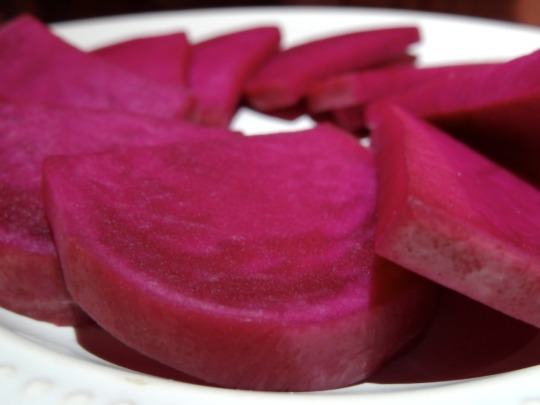
[ID: A circle of overlapping semi-circular bright pink pickles arranged on a plate, viewed from a low angle. End ID]
مخلل اللفت / Mukhallal al-lifit (Pickled turnips)
The word "مُخَلَّل" ("mukhallal") is derived from the verb "خَلَّلَ" ("khallala"), meaning "to preserve in vinegar." "Lifit" (with diacritics, Levantine pronunciation: "لِفِتْ"), "turnip," comes from the root "ل ف ت", which produces words relating to being crooked, turning aside, and twisting (such as "لَفَتَ" "lafata," "to twist, to wring"). This root was being used to produce a word meaning "turnip" ("لِفْتْ" "lift") by the 1000s AD, perhaps because turnips must be twisted or wrung out of the ground.
Pickling as a method of preserving produce so that it can be eaten out of season is of ancient origin. In the modern-day Levant, pickles (called "طَرَاشِيّ" "ṭarāshiyy"; singular "طُرْشِيّ" "ṭurshiyy") make up an important culinary category: peppers, carrot, olives, eggplant, cucumber, cabbage, cauliflower, and lemons are preserved with vinegar or brine for later consumption.
Pickled turnips are perhaps the most commonly consumed pickles in the Levant. They are traditionally prepared during the turnip harvest in the winter; in the early spring, once they have finished their slow fermentation, they may be added to appetizer spreads, served as a side with breakfast, lunch, or dinner, eaten on their own as a snack, or used to add pungency to salads, sandwiches, and wraps (such as shawarma or falafel). Tarashiyy are especially popular among Muslim Palestinians during the holy month of رَمَضَان (Ramaḍān), when they are considered a must-have on the إِفْطَار ("ʔifṭār"; fast-breaking meal) table. Pickle vendors and factories will often hire additional workers in the time leading up to Ramadan in order to keep up with increased demand.
In its simplest instantiation, mukhallal al-lifit combines turnips, beetroot (for color), water, salt, and time: a process of anaerobic lacto-fermentation produces a deep transformation in flavor and a sour, earthy, tender-crisp pickle. Some recipes instead pickle the turnips in vinegar, which produces a sharp, acidic taste. A pink dye (صِبْغَة مُخَلَّل زَهْرِي; "ṣibgha mukhallal zahri") may be added to improve the color. Palestinian recipes in particular sometimes call for garlic and green chili peppers. This recipe is for a "slow pickle" made with brine: thick slices of turnip are fermented at room temperature for about three weeks to produce a tangy, slightly bitter pickle with astringency and zest reminiscent of horseradish.
Turnips are a widely cultivated crop in Palestine, but, though they make a very popular pickle, they are seldom consumed fresh. One Palestinian dish, mostly prepared in Hebron, that does not call for their fermentation is مُحَشّي لِفِتْ ("muḥashshi lifit")—turnips that are cored, fried, and stuffed with a filling made from ground meat, rice, tomato, and sumac or tamarind. In Nablus, tahina and lemon juice may be added to the meat and rice. A similar dish exists in Jordan.
Turnips produced in the West Bank are typically planted in open fields (as opposed to in or under structures such as plastic tunnels) in November and harvested in February, making them a fall/winter crop. Because most of them are irrigated (rather than rain-fed), their yield is severely limited by the Israeli military's siphoning off of water from Palestine's natural aquifers to settlers and their farms.
Israeli military order 92, issued on August 15th, 1967 (just two months after the order by which Israel had claimed full military, legislative, executive, and judicial control of the West Bank on June 7th), placed all authority over water resources in the hands of an Israeli official. Military order 158, issued on November 19th of the same year, declared that no one could establish, own, or administer any water extraction or processing construction (such as wells, water purification plants, or rainwater collecting cisterns) without a new permit. Water infrastructure could be searched for, confiscated, or destroyed at will of the Israeli military. This order de facto forbid Palestinians from owning or constructing any new water infrastructure, since anyone could be denied a permit without reason; to date, no West Bank Palestinian has ever been granted a permit to construct a well to collect water from an aquifer.
Nearly 30 years later, the Interim Agreement on the West Bank and the Gaza Strip (also called the Oslo II Accord or the Taba Agreement), signed by Israel and the Palestine Liberation Organization (PLO) in 1995, officially granted Israel the full control over water resources in occupied Palestine that it had earlier claimed. The Argreement divided the West Bank into regions of three types—A, B, and C—with Israel given control of Area C, and the Palestinian Authority (PA) supposedly having full administrative power over Area A (about 3% of the West Bank at the time).
In fact, per article 40 of Annex 3, the PA was only allowed to administer water distribution in Area A, so long as their water usage did not exceed what had been allocated to them in the 1993 Oslo Accord, a mere 15% of the total water supply: they had no administrative control over water resources, all of which were owned and administered by Israel. This interim agreement was to be returned to in permanent status negotiations which never occurred.
The cumulative effect of these resolutions is that Palestinians have no independent access to water: they are forbidden to collect water from underground aquifers, the Jordan River, freshwater springs, or rainfall. They are, by law and by design, fully reliant on Israel's grid, which distributes water very unevenly; a 2023 report estimated that Israeli settlers (in "Israel" and in the occupied West Bank) used 3 times as much water as Palestinians. Oslo II estimations of Palestinians' water needs were set at a static number of million cubic meters (mcm), rather than an amount of water per person, and this number has been adhered to despite subsequent growth in the Palestinian population.
Palestinians who are connected to the Israeli grid may open their taps only to find them dry (for as long as a month at a time, in بَيْت لَحْم "bayt laḥm"; Bethlehem, and الخَلِيل "al-khalīl"; Hebron). Families rush to complete chores that require water the moment they discover the taps are running. Those in rural areas rely on cisterns and wells that they are forbidden to deepen; new wells and reservoirs that they build are demolished in the hundreds by the Israeli military. Water deficits must be made up by paying steep prices for additional tankards of water, both through clandestine networks and from Israel itself. As climate change makes summers hotter and longer, the crisis worsens.
By contrast, Israeli settlers use water at will. Israel, as the sole authority over water resources, has the power to transfer water between aquifers; in practice, it uses this authority to divert water from the Jordan River basin, subterranean aquifers, and بُحَيْرَة طَبَرِيَّا ("buḥayrat ṭabariyyā"; Lake Tiberias) into its national water carrier (built in 1964), and from there to other regions, including the Negev Desert (south of the West Bank) and settlements within the West Bank.
Whenever Israel annexes new land, settlers there are rapidly given access to water; the PA, however, is forbidden to transport water from one area of the West Bank to another. Israel's control over water resources is an important part of the settler colonial project, as access to water greatly influences the desirability of land and the expected profit to be gained through its agricultural exports.
The result of the diversion of water is to increase the salinity of the Eastern Aquifer (in the West Bank, on the east bank of the Jordan River) and the remainder of the Jordan that flows into the West Bank, reducing the water's suitability for drinking and irrigation; in addition, natural springs and wells in Palestine have run dry. In this environment, water for drinking and watering crops and livestock is given priority, and many Palestinians struggle to access enough water to shower or wash clothing regularly. In extreme circumstances, crops may be left for dead, as Palestinian farmers instead seek out jobs tending Israeli fields.
Some areas in Palestine are worse off in this regard than others. Though water can be produced more easily in the قَلْقِيلية (Qalqilya), طُولْكَرْم (Tulkarm) and أَرِيحَا ("ʔarīḥā"; Jericho) Districts than in others, the PA is not permitted to transfer water from these areas to areas where water is scarcer, such as the Bethlehem and Al-Khalil Districts. In Al-Khalil, where almost a third of Palestinian acreage devoted to turnips is located [1], and where farming families such as the Jabars cultivate them for market, water usage averaged just 51 liters per person per day in 2020—compare this to the West Bank Palestinian average of 82.4 liters, the WHO recommended daily minimum of 100 liters, and the Israeli average of 247 liters per person per day.
As Israeli settlement גִּבְעַת חַרְסִינָה (Givat Harsina) encroached on Al-Khalil in 2001, with a subdivision being built over the bulldozed Jabar orchard, the Jabars reported settlers breaking their windows, destroying their garden, throwing rocks, and holding rallies on the road leading to their house. In 2010, with the growth of the קִרְיַת־אַרְבַּע (Kiryat Arba) settlement (officially the parent settlement of Givat Harsina), the Jabars' entire irrigation system was repeatedly torn out, with the justification that they were stealing water from the Israeli water authority; the destruction continued into 2014. Efforts at connecting and expanding Israeli settlements in the Bethlehem area continue to this day.
Thus we can see that water deprivation is one tool among many used to drive Palestinians from their land; and that it is connected to a strategy of rendering agriculture impossible or unprofitable for them, forcing them into a state of dependence on the Israeli economy.
Turnips, as well as cabbage and chili peppers, are also grown in the village of وَادِي فُوقِين (Wadi Fuqin), west of Bethlehem. In 2014, Israel annexed about 1,250 acres of land in Wadi Fuqin, or a third of the village's land, "effectively [ruling] out development of the village and its use of this land for agriculture." Most of this land lies immediately to the west of a group of settlements Israel calls גּוּשׁ עֶצְיוֹן ("Gush Etzion"; Etzion Bloc). Building here would link several non-contiguous Israeli settlements with each other and with القدس (Al-Quds; "Jerusalem"), hemming Palestinians of the region in on all sides (many main roads through Israeli settlements cannot be used by anyone with a Palestinian ID). [2] PLO executive committee member Hanan Ashrawi said that the annexation, which was carried out "[u]nder the cover of [Israel's] latest campaign of aggression in Gaza," "represent[ed] Israel’s deliberate intent to wipe out any Palestinian presence on the land".
This, of course, was not the beginning of this strategy: untreated sewage from Gush Etzion settlements had been contaminating crops, springs, and groundwater in Wadi Fuqin since 2006, which also saw nearly 100 acres of Palestinian land annexed to allow for expansion of the Etzion Bloc.
All of this has obviously had an effect on Palestinian agriculture. A 1945–6 British survey of vegetable production in Palestine found that 992 dunums were devoted to Arab turnip production (954 irrigated and 38 rain-fed; no turnip production was attributed to Jewish settlers). A March 1948 UN report claimed that "[i]n most districts the markets are well-supplied with all the common winter vegetables—cabbages, cauliflowers, lettuce and spinach; carrots, turnips and and beets; beans and peas; green onions, eggplants, marrows and tomatoes." By 2009, however, the area given to turnips in Palestine had fallen to 918 dunums. Of these, 864 dunums were irrigated and 54 rain-fed. This represents an increase in unirrigated turnips (5.8%, up from 3.9%) that is perhaps related to difficulty in obtaining sufficient water.
Meanwhile, Israel profits from its restriction of Palestinian agriculture; it is the largest exporter of turnips in West Asia (I found no data for turnip exports from Palestine after 1922, suggesting that the produce is all for local consumption).
The pattern that Ashrawi called out in 2014 continued in 2023, as Israel's genocide in Gaza occurs alongside the continued and escalating killing and expulsion of West Bank Palestinians. The 2014 annexations, which represented the largest land grab for over 30 years and which appeared to institute a new era of state policy, have been followed up in subsequent years with more land claims and settlement-building.
Israeli military and settler raids and massacres in the West Bank, which had already killed 248 in 2023 before the حَمَاس (Hamas) October 7 offensive had taken place, accelerated after the attack, with forced expulsions of Palestinians (including Bedouin Arabs), and harassment, raids, kidnappings, and torture of Palestinians by a military armed with rifles, tanks, and drones. This violence has been opposed by armed resistance groups, who defend refugee camps from military raids with strategies including the use of improvised explosives.
Support Palestinian resistance by buying an e-sim for distribution in Gaza; donating to help two Gazans receive medical care; or donating to help a family leave Gaza.
[1] 918 dunums were devoted to turnips according to the Palestinian Central Bureau of Statistics (PCBS) report for 2009; the 2008 PCBS report attributes 253 dunums of turnip cultivation to Al-Khalil ("Hebron") for 2006–7.
[2] Today, Gush Etzion is connected to Al-Quds by an underground road that runs beneath the Palestinian Christian town of بَيتْ جَالَا (Bayt Jala).
Ingredients:
Makes 2 1-liter mason jars.
500g (4 medium) turnips
1 beetroot
1 medium green chili pepper (فلفل حار خضرة), halved
2 small cloves garlic, peeled
1 liter (4 cups) distilled or filtered water
25g coarse sea salt (or substitute an equivalent weight of any salt without iodine)
Some brining recipes for lifit call for the addition of a spoonful of sugar. This will increase the activity of lactic-acid-producing bacteria at the beginning of the fermentation, producing a quicker fermentation and a different, sourer flavor profile.
Instructions:
1. Clean two large mason jars thoroughly in hot water (there is no need to sterilize them).
2. Scrub vegetables thoroughly. Cut the top (root) and bottom off of each turnip. Cut each turnip in half (from root end to bottom), and then in 1 cm (1/2") slices (perpendicular to the last cut). Prepare the beetroot the same way.
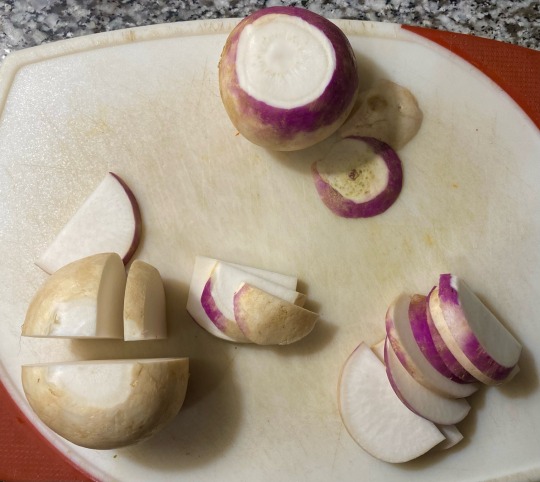
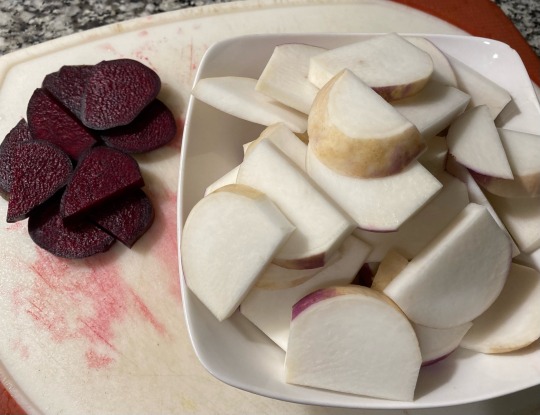
If you need your pickles to be finished sooner, cut the turnips into thinner slices, or into thick (1/2") baton shapes; these will need to be fermented for about a week.
3. Arrange turnip and beet slices so that they lie flat in your jars. Add garlic and peppers.
4. Whisk salt into water until dissolved and pour over the turnips until they are fully submerged. Seal with the jar's lid and leave in a cool place, or the refrigerator, for 20–24 days.

The amount of brine that you will need to cover the top of the vegetables will depend on the shape of your jar. If you add more water, make sure that you add more salt in the same ratio.

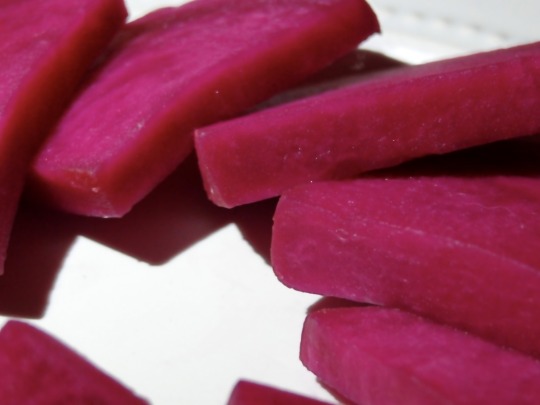
292 notes
·
View notes
Text










LN Channel Change AU
Sequel: “Seven” {1} {2} {3} {here/final}
And they lived happily ever after.
Or did they?
We've established our main characters Mono (TV/space-time) and Six (Soul Sucking) have strange supernatural powers. I wanted Seven to have one too. (Hydrokinesis aka water bending)
Notes for how I came up with Seven's powers and the deeper meaning behind his interaction with Mono:
1. Each child has nightmare prophecies (something to do with Mono's time loop?) at the beginning of their stories. Six's is the Lady, Mono's is the door that leads to the Thin Man, and Seven's is being pulled underwater. Six and Mono's nightmare visions are fulfilled at the end of their stories; revealing that the thing they dreamed about, they essentially become or usurp. Seven's differs. His dream resolves in act 1 and he kills the Granny, the creature assumed to be the one pulling him underwater in his nightmare. But what if Seven's dream prophecy was still valid... even post-Granny? Being dragged underwater... for a different fate?
2. Seven is the only main cast character shown with the ability to swim.
3. "Seven Seas" anyone? Water is a symbol of purification & life, hence, Seven gains his new powers after he survived and Mono broke the timeline loop to start fresh. "Washing it away" so to say.
4. Water is a liquid; passive in nature, but powerful in circumstance. Seven is kind and sneaky but kills the Granny when continuously attacked and threatened by her. He does the same to the Octopus monster.
5. Water molecules have adhesion and cohesion, meaning water likes to stick to itself, and stick to other things. Seven has an attachment to Nomes. He is always drawn to other people and other creatures, wanting to help them. His belief is that survival chances are higher amidst a group. Water is also known for containing life, no matter how strange or deep, such as ocean fish that often travel in schools/packs often to confuse or fight off predators, thus, another reference to Seven's new life, and his teamwork with Nomes and Mono.
6. Seven is often in fandom depicted by a circle. A water droplet.
7. Seven collects flotsam; typically boat debris, but in this case, bottled messages that come from the sea. Yet another connection to water.
All this indicates heavy implication and well-fitting power to bestow hydrokinesis onto Seven. I was inspired by the INSIDE game's drowning chapter and Stanley and Stanford's secret boat hide-out on the beach from Gravity Falls. Which is why I have selected Mono, Seven, and all their future friends to a lovely and sunny (future) beach house, far away from everything they've suffered. And living near the largest body of water on the planet with a kid with hydrokinesis? ...Certainly has its perks!
But Seven gaining powers is important to not only their survival but also him. He was still nervous about Mono. He knew Mono was very powerful and mysterious. In more ways than one. Mono is stronger than him and can also use telekinesis on objects on the beach. He's a better food hunter and seems more like a leader.
Seven also likes to lead, but he felt outshined by Mono. (I don't portray that well in my comic) Seven is weaker and defenseless. His only shining quality in comparison is his ability to swim, but even that can only get him so far. He risks his life for his Nome friends and loses his life doing so. Or so he thought. By a miracle, his powers over water awaken. He drains the monster of its water, beaching it. He walks to Mono in a new light. It's a new him. He holds up his hands as if to say "See? I'm like you now." He's leveled the playing field. (It also helps that he now has jurisdiction over power Mono cannot interact with) Now they are truly equal. Two kings; one of land, one of sea, both ruling the island in equal standing. Seven will never again feel like a burden left behind.
(Seven's powers activating also has something to do with the fact he bit the Octopus creature to save the Nome. Mono and Six both consume their powerful prophesized enemies to gain some of their power, if they didn't already have some before. Seven biting into the Octopus's flesh and unknowingly consuming some of it may have jumpstarted his power deep within him, on top of him encountering Mono; supernatural kid extraordinaire that brought him through a tower wormhole to escape the city)
~~~
A threequel is planned, and maybe the last addition to this series, but the next one is not fully fleshed out yet so it may be another year until I can really touch upon it yet.
Otherwise, hope you guys enjoyed!
#little nightmares#little nightmares 2#channel change#channel change au#LN#LN AU#LN mono#LN seven#the runaway kid#mono#seven#comic#long post
773 notes
·
View notes
Text
Lily and James — the alchemical Queen and King. Lily is the main symbol of the entire saga.
In Harry Potter, there are two levels - the mundane and the symbolic. On the mundane level, Lily is a character with her own strengths and weaknesses. On the symbolic level, Lily is the main symbol of the entire saga. Perhaps that's why there's so little talk about her because symbolically Lily is what everyone strives for, everyone searches for but cannot find. Harry learns more about Lily only before the final battle, and there's a reason for that.
It's no secret that HP books are heavily laden with alchemical and Christian symbolism. I'm not religious, and to me, all these symbols are just cultural codes that have had a significant influence on almost all classic literature and art.

Philipp Otto Runge, Chagall, Goethe — they're all alchemical codes
Firstly, alchemy is not about literally turning lead into gold, it's a path of spiritual development, a path of transformation, a "hero's journey," the journey of the Son returning to the Father. Alchemical transformation is described in the text "The Chymical Wedding of Christian Rosenkreutz." This is the third manifesto of the Rosicrucian Brotherhood.
So, lilies are a very ancient symbol.
According to Jewish legends, the lily grew in Eden just at the time of Eve's temptation by the devil and could be defiled by him, but even amid temptation, it remained as pure as it was, and no dirty hand dared to touch it. In early medieval depictions, Christ was placed against a backdrop of lilies or in the lily flower, seen as a symbol of the Virgin Mary. The orange lily often symbolizes the blood of Christ.

Symbolically, Lily is the love of God, a divine spark, and the blood of Christ itself, which was shed in the name of redemption and salvation to atone for the sins of all humanity. And what is the blood of Christ? In Christian tradition, the blood of Jesus Christ is a symbol of the life-giving and saving spirit of God.
By the way, lilies and roses were often confused in translations, and symbolically they are the same. Many suspected that the Rosicrucians' rose is a stylized version of the Egyptian and Indian flowering lotus, and the lotus has often been considered a water lily (they are different, but symbolically they merged). But calling the main character Rose would be too dull and obvious a reference.
Lily - symbolically, she is both the mother of Christ and the Spirit of God herself, the bearer of divine love, to which all seekers are drawn. This is not the only meaning, but for now, it's enough.
God is love, says John the Apostle. (Remus John Lupin, hehe. It was absolutely unnecessary to know his middle name. It's intentionally inserted because each of the marauders, except Sirius, by name signifies one of the disciples closest to Christ. Sirius is a separate story, he signifies something completely different.)
And who is drawn? Well, primarily we see two - James and Snape.
One of the most important things we learn about James is that he's a deer. The deer is a well-known symbol. In myths and folk beliefs, the deer was associated with the soul's aspiration to heaven and purification.
"As the deer pants for streams of water, so my soul pants for you, my God" Ps. 42: 1
In the Alexandrian "Physiologus," there's an ancient enmity between the stag and the serpent. The serpent hides from the foe in the clefts of the earth, but the stag, with the help of water, draws out the serpent and defeats it. (Water has always been a symbol of the serpent, even in Slytherin's element water, but the stag fights the serpent not with ordinary water but with the water of baptism. The snake has another important meaning for alchemy, but more on that later.)

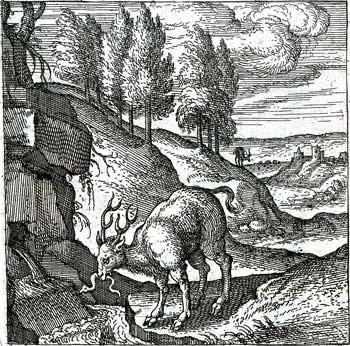
Snape belongs to the Serpent, to secret knowledge, occult knowledge, "philosophical" reason, dark magic, which has always been contrary to the divine nature in Christian understanding and originated from the devil. James belongs to the Lion and the Deer.
The Lion is a typical alchemical symbol. Also, the Red Lion is Christ. Gryffindor embodies the soul's aspiration towards light and transformation, towards salvation. By the way, St. Godric (the hermit) also had his own pet deer, which he saved.

The deer seeks love, the spirit of God, the divine spark, God Himself, and in this persistent pursuit is shown James's path, as a seeker and as an alchemist. The Potters — if not alchemists themselves, then at least from the lineage of alchemists — the Peverells (The symbol of the Deathly Hallows is an alchemical-masonic symbol). And this means that the Potters are at least seekers; in their souls, there is a desire to find the divine and undergo transformation. The Potters have a strong hatred for the 'serpentine essence' of evil, and this is what needs to be transformed. (By the way, the graveyard is located near St. Jerome's Church. Besides translating the Bible into Latin, Jerome also healed and tamed a lion).
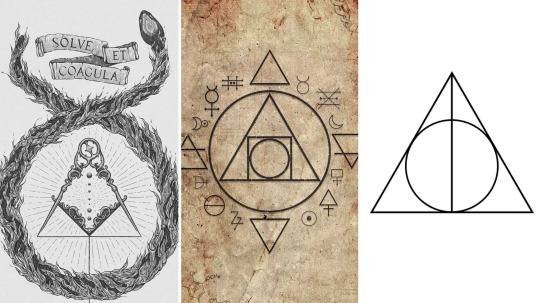
Masonic-alchemical symbol. Symbol of the philosopher's stone. Symbol of the Deathly Hallows. Solve et coagula is a principle of alchemy meaning "dissolve and coagulate".
An alchemist is a gardener, and this is another interesting reference to James and Lily. The way James tries to find an approach to Lily is an alchemical process. The alchemist tends to the Garden. In Vrisvik's Great Work (the Magnum Opus), it appears as the Garden of the Wise. The Gates to the Garden of the Wise for the Chosen become the process of dissolving "our Substance." James manages to approach Lily only when he dissolves his Ego. The Ego is the main enemy on the path to transformation.
The tradition of "hermetic gardening," that is, "cultivating the flowers of Wisdom in one's garden," becomes a leading line in alchemical symbolism. James cultivates wisdom.
While Snape cultivates "dark knowledge," although his soul also strives for light and love. But Snape is still too captured by his Ego, too captivated by base emotions, a thirst for revenge, recognition, or power, a craving for "secret knowledge." He cannot resist it, no matter how much he may strive for Lily, for the divine transformation of his spirit, and James, still dwelling in his Ego, instead of showing mercy to Snape, pushes him further away. The stag fights the serpent, but God is love. Ultimately, Snape temporarily closes off the paths of alchemical transformation for himself.
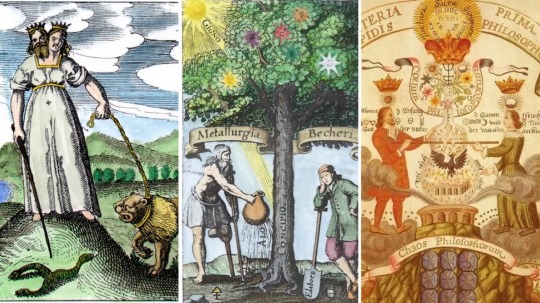
The Rebis is the end product of the alchemical magnum opus or great work. The lion must dissolve the serpent. Hermetic gardening. The alchemical wedding: the Queen and the King.
But besides all this, the deer is also a symbol of eternal renewal and victory over death ("The last enemy that shall be destroyed is death" 1 Corinthians 15:26 ). A symbol of Christ. His constantly renewing antlers represent eternal life.
In the original Greek of the New Testament, the names Jacob and James are variants of the same root—Yaaqob. James is an active force, a seeker, an investigator, a supplanter. James the Great was of a rather impulsive character, but everyone was also amazed by his courage, he was the only one who acknowledged Christ as the Messiah. And he is the only apostle whose death is described in the New Testament. He dies at the hands of King Herod, a cynical and evil king who was willing to murder babies for his purpose. James also dies at the hands of Voldemort, who is willing to kill a baby for his purpose.
Moreover, it was Saint James who was considered the heavenly patron of alchemists. His tomb was located in Santiago de Compostela, which was the oldest center of adepts. It was there, in 1378, after twenty years of unsuccessful attempts to decipher the Book of Hieroglyphic Figures, that Nicolas Flamel, the most famous alchemist of the Middle Ages, went. By the way, Shell Cottage... the scallop shell is a symbol of the apostle James and the "trademark" of the Way of St. James. Shell Cottage is also alchemical. It is there that Harry sees the symbol of the Deathly Hallows around Lovegood's neck.

James is a seeker. Lily is a symbol of the divine spirit, sparks, transformation. That to which all must ultimately come, that which must change in our world in the image of God. But for now, our world is seized by evil, by the antichrist. To defeat death means to defeat the antichrist in one's soul.
James finds Lily. The Soul finds the Spirit. The Spirit descends into the Soul. The King and Queen marry—and a new life is born, another hero capable of defeating the evil that has engulfed the world, capable of cleansing the world of evil. The connection between Harry and Christ is no secret to anyone.
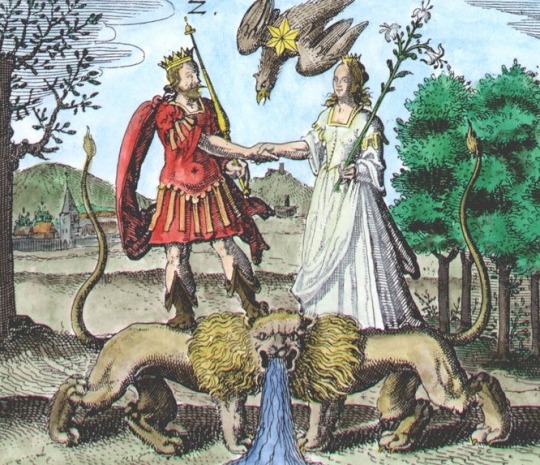
The power of love conquers death. A rune appears on Harry's forehead—Sowilo rune—the victory rune, the sun rune, the irreversible rune. It symbolically serves as the key to the world of Alfheim—the world of the light elves, that is, the bright ideas, the prototypes of the buddhial plane, the ideality in this world.

The key to God. Harry becomes marked. His scar is a reminder to him that he came into this world not just by chance, but to destroy evil. And coming into this world, materializing, a person invariably receives a particle of the antichrist within himself. That's how this world works. Evil is in the soul of each of us, and through the Great Work, a person must purify himself.
And none can live while the other survives, because they mutually exclude each other by their very nature. Christ and antichrist.
But Harry has a difficult path ahead, the path of the Great Work before he can achieve victory. And that will be the theme of all 7 books, 7 years — exactly 7 days is the duration of The Chymical Wedding of Christian Rosenkreutz for the transformation oh his soul, for victory over death.
115 notes
·
View notes
Note
do you think sasuke is religious or upholds his clan's religious practices? i was rereading and in the part where they go to resucitate the hokages orochimaru says "there's nothing left of the uchiha's nakano shrine", to which sasuke answers "the exterior doesn't matter" and it got me wondering
HI YES thank you so much for sending this ask. it's very close to me. elaborated a Lot under the cut but tl;dr - yes.
he is religious in the only way he remembers how to be. preserving Uchiha tradition and culture is deeply important to him. when he said the exterior of Nakano shrine didn't matter, sure he was referring to the fact that there was a hidden underground level... but it meant much more than that.
genocide doesn't just claim lives, it claims languages and religions and every facet of culture. konoha has been known to participate in the censorship and eradication of culture. this assimilation functions as an extension of genocide.
by virtue of being a survivor, i think sasuke feels an obligation to "carry the torch". since he was so young when the massacre occurred, it's likely a lot of practice and customs have been lost altogether. this is distressing to him. even during his character introduction at 12 years old, his clans "restoration" was first and foremost in his mind. to me this statement was never about re-population as many people interpret, but about justice, pride, and culture.

he feels as though the Uchiha name has been "tainted" and it is his responsibility to "purify" it. but what that means to him shifts over time.

the Uchiha clan's religion is obviously based on and deeply tied to the Shinto religion, just like the clan's jutsu and kekkei genkai. many Uchiha jutsu are named after Shinto deities.
this part i am not going to delve into too much yet because one day i will probably write a paper about it, but one of the tenets of Shinto belief is the importance of purity. Shinto practice and customs are regionally variant but the practice of purification is central. death is considered to be extremely impure. this context is deeply relevant to Sasuke's belief system and the way he thinks about himself and his clan.
it is likely that the uchiha religion is closed, evidenced by nakano shrine being kept a secret. sasuke not only has to contend with the fact that the remaining pieces of his culture are guarded and hidden, requiring the use of high-level dojutsu to decipher, but also that any of it may have been altered. the revelation that the stone tablet was altered in order to facilitate madara's manipulation and further subjugation of the uchiha was destabilizing. sasuke has to put the pieces of his religion back together with mostly his memories to rely on.
many parallels can be drawn between sasuke and the sun goddess Amaterasu. when she is betrayed by her brother Susanoo, she withdraws into a cave and plunges the world into darkness. Susanoo conspires to manipulate her into leaving the cave, and then binds her.
this gender reversal is sort of fascinating. Amaterasu and Susanoo contradict the popular notions about the sun and moon and the masculine and feminine. of course this reminds me of sasuke as well, because everything does.
sasuke is typically associated with the waning crescent, the phase just before a new moon, and itachi with a full moon. since sasuke is associated with the moon, the yin, and the feminine, it would logically follow that he would be passive like water; low like a valley. however, he subverts this expectation.
i believe this is a big part of why he makes so many people uncomfortable. he is fire and lightning and he is not a perfect victim.
after speaking to the kage and revealing the secrets of Nakano shrine, he resolves himself to burn the world down and be reborn like a phoenix. like the waning crescent before a new moon.

he is not "pure" the way itachi expects, kishimoto states, or many fans anticipate. he has strong convictions and he is confident. he is not apologetic and he is impossible to ignore.
the first time we ever see sasuke associated with the sun is after he learns the truth about the massacre. he leaves his cave. he sheds hebi and becomes taka, predator instead of prey. he is ready to spill as much blood as it takes.
i have many ideas about what Uchiha religious customs might look like, and many of them concern fire. the uchiwa fan that stokes the flames is their crest. they are seen as fully fledged members of the clan once they can perform katon jutsu. the shrine that houses the Uchiha's patron deity has eternal flames lit.
drawing from my own religion, one of my favorite metas draws a parallel between the Uchiha fire affinity and
אש תמיד (Aish tamid)
which means eternal flame. (sorry for line break, tumblr hates right to left languages). Aish tamid refers to the flame in the temple of Jerusalem that was always kept alight before its desecration by the greeks. just like the torches located in Nakano shrine.

the greeks attempted to hellenize and extinguish Jewish culture. they outlawed observance of Shabbat and circumcision, spat in the face of kashrut by sacrificing pigs in the temple, and even built statues of their gods within. the Jewish people rebelled against them and the flame was rekindled.
rebellion, justice, and pride in culture is in the spirit of fire. unending, always enduring. Sasuke and the Uchiha clan embody this, their crests always emblazoned on their clothes even at the cost of armor. from Madara's rage, to the coup, to Sasuke's revenge, justice is an integral component to the Uchiha ethos.
to me this is a really interesting contrast to the will of fire. the will of fire is the ideal of nationalism-- putting the state before the self. this idea is lauded as heroism. it was originated by the senju, no wonder.
meanwhile, the uchiha clan with their fire affinity and deeply spiritual connection to flame are seen as transgressors. they are seen as disruptive to the ideal of the "will of fire" due to their strong cultural identity. they refuse to assimilate into the dominant culture. they prioritize their love and familial bonds with each other over konoha's interests.

naruto wiki im going to kill you
they are labeled with the opposing "curse of hatred".

it is no surprise then that itachi was praised for his strong "will of fire" for carrying out the massacre-- putting the well-being of the state over the lives of his family. groomed into following the senju doctrine and abandoning his own culture. assimilated and outcast.
in modern culture Aish tamid is kept alight by the continuation of religious practice- praying and studying Torah keep the flame burning. "The exterior doesn't matter". the flame is already burning within Sasuke.
sasuke carries on whatever pieces of his culture he remembers, and he prays in the dark, and he thinks of his mother with her hands clasped at the kamidana, and he visits shrines often on his journey. he lights incense and he burns brightly. and he walks on.
#naruto meta#uchiha sasuke#txt#ok whatever sorry this is 10 million words i couldn't figure out how to trim it down more#thanks for sending me this hope it is interesting#ask
196 notes
·
View notes
Text
How to Use Herbs : Rosemary
Hwello there. We have talked about rosemary and its uses in a previous post. If you haven't read it, please click here: Rosemary
Now I shall provide some spells, tonics, recipes and etc on where you can utilize it. Let us begin :)

Author's Note: From I noticed a part is usually a teaspoon. You can add more according to your needs, but I would always start with that measurement first.
Alchemist Formula for Binding:
One part benzoin gum (Saturn, binding)
One part patchouli (Saturn,binding)
One part Solomon's seal (Saturn, protective)
One part rosemary oil (Saturn, protective)
One part frankincense oil (Sun, success)
Mental Focus Magical Tea:
I part rosemary
1/2 part spearmint
1 cup of boiling water
Mix herbs in a small jar
To brew, pour 1 cup of boiling water over 1 teaspoon of the herbal blend.
Steep for 5 - 7 minute. Strain and drink.
Spells:
Remembrance for Lost Love (Heartache Healer)
6 drops of rosemary oil
3 drops of peppermint oil
1 drop of lavender oil
White candle
Add the oil to the top of the candle, one at a time, in a clockwise direction around the wick.
LIght the candle and gaze into the flame
Visualize your fond memories of the person who left your life. As you do this say, "I thank you for the time we had together, I thank you for the love we shared, I thank you for being an important part of my life. We have parted, we move on, we remember. I wish you the best life has to offer and hope you have found happiness."
Allow the candle to burn out of its own and dispose of the remaining wax away from your home or bury it in the spot you and the past partner enjoyed together.
Broom Cleansing Spell
Use one or any combination of the following botanicals: broom, cedar,fennel, hyssop, rosemary, sage, vervain.
Arrange the botanicals and tie them to the bottom of a branch withraffia, visualizing, charging and knotting. (Any branch may be used,however an ash branch is considered particularly powerful.)
Sprinkle with salted water or any preferred purification formula.
Sweep the area.
Disassemble the broom outside, away from the cleansed space.
Bury the components in the ground or toss them into living waters, flowing away from you.
Ghost Keep Away Spell (Boundary Line Spell)
Place three peeled cloves of garlic in a bowl, together with one handful of sea salt and one handful of fresh rosemary leaves.
Grind and mash the ingredients together.
Sprinkle them to create a boundary, as needed.
Bad Habits Bath
Add the following to a tub filled with warm water:
Essential oil of clary sage
Essential oil of frankincense
Essential oil of lavender
Essential oil of lemongrass or May Chang
Essential oil of rosemary
Enter the bath and inhale the fragrance, and accompany with affirmations and positive visualizations.
Kitchen Witch Recipes:
Super-Quick Bonus Recipe for Gwion’s Red Onion Pickle Bliss
Fills one pint-sized jar
Prep Time: 10 minutes
Cooking Time: 20 minutes, plus 30 minutes to cool in the fridge
1 medium red onion
3 tablespoons sugar
1/2 cup water
10 black peppercorns
2/3 cup white wine vinegar,
rice vinegar, or apple cider vinegar
1/4 teaspoon red pepper flakes
1 sprig rosemary
1 clove garlic, peeled and halved
Slice the onion very thinly and place it in your clean, dry jar. Set it aside.
Add the rest of the ingredients to a medium saucepan and bring to a boil until the sugar has fully dissolved. Stir carefully so you don’t break the rosemary. The sprig is in there to add flavour, and you’ll discard it before the next step.
Let the pickling mixture (the water, vinegar, and spices) cool down for about 10 minutes. Discard the sprig of rosemary and pour the remaining
ingredients into the jar of onions. Make sure all of the onions are submerged
in the picking liquid. If you have to, use a spoon to push the onions down in the jar. Seal the jar and put it in the fridge to cool. The onions are ready to eat once they are cool, about 30 minutes.
Serve them on avocado toast, burgers, salads, or just with a fork straight out of the jar. Remember to kiss your partner or partners before eating the onions out of the jar, unless they’re into pungent kisses.
Goat for a God: Roasted Goat Leg with Grape Molasses
Great for Deities: Dionysus, Pan and Thor
Serves : 6
Prep Time: 30 minutes
Cooking Time: 2 hours and 30 minutes
1 goat leg (about 3 pounds)
1/4 cup + 1 tablespoon olive oil
2 teaspoons salt
1 teaspoon cumin
2 teaspoons black pepper
4 tablespoons grape molasses
2 cloves garlic, minced
1 teaspoon coriander
2 sprigs fresh rosemary
1 cup white wine + one glass for sipping and toasting while cooking (use mead if you're cooking this for Thor)
1 bay leaf
2 large carrots, chopped into
1" chunks
1 celery root, peeled and chopped into 1" cubes
Open the bottle of white wine or mead and take a hefty drink. (This is optional but deities do like when you drink with them but they can respect if you don't partake.)
Preheat the oven to 375° F.
Liberally season the goat leg with salt and pepper.
Rub the minced garlic all over the goat leg too. If it helps, poke a few holes in the goat leg so you can get the garlic right into the meat.
Place the rosemary sprigs and bay leaf in the bottom of a large roasting pan and put the goat leg right on top. Add the carrots and celery root around the edges. Pour the olive oil all over the goat and rub it around. Coat the carrots and celery root too.
Pour the white wine around the bottom of the roasting pan.
Loosely cover with kitchen foil and put the whole pan into the oven for 2 hours.
About an hour and forty-five minutes into the cooking process, it’s time to make the glaze.
Mix the grape molasses—which is a super-condensed syrup made of grape must—in a bowl with a tablespoon of olive oil, the coriander, and the cumin. You can substitute honey for the grape molasses if for Thor.
At the two-hour mark, pull the roasting pan out of the oven and paint the goat with the grape (or honey) and spice glaze.
Pop the goat and veggies, uncovered, back into the oven for another 20 minutes or until the internal temperature reaches at least 145° F.
When you’re ready to serve this dish, scoop the veggies into a bowl (fornow) and put the goat leg on a platter. If you have access to one, get a cedar plank and serve the goat on it.
Medical Tonics and Infusions:
Infusion- An infusion is the simplest way to prepare the more delicate aerial parts of plants, especially leaves and flowers, for use as a medicine or as a revitalizing or relaxing drink. It is made in a similar way to tea, using either a single herb or a combination of herbs, and may be drunk hot or cold.
Pot Infusion
For a cup:
1 tsp (2–3 g) dried or 2 tsp (4–6 g) fresh herb (or mixture of herbs) to a cup of water
For a pot:
20 g dried herb or 30 g fresh herb (or a mixture of different herbs) to 2 cups (500 ml) of water
Warm the pot, then add the herb.
Pour in water that has just boiled, replace the lid, and infuse for 10 minutes.
Strain some of the infusion into a cup. A teaspoon of honey may be added if desired.
Storage:
Store in a covered jug in a refrigerator or cool place for up to 24 hours.
Tonic Making
Standard Quantity:
200 g dried or 300 g fresh herb chopped into small pieces to 1 quart (1 liter) alcohol—vodka of 35–40% alcohol is ideal, although rum hides the taste of bitter or unpalatable herbs
Standard Dosage:
Take 1 tsp (5 ml) 2 –3 times a day diluted in 1 tbsp plus 1 tsp (25 ml) of water or fruit juice.
Place the herb in a large, clean glass jar and pour on the alcohol, ensuring that the herb is covered. Close and label the jar.
Shake well for 1–2 minutes and store in a cool dark place for 10–14 days, shaking the jar every 1–2 days.
Set up the wine press, placing a muslin or nylon mesh bag securely inside. Pour in the mixture and collect the liquid in the jug.
Slowly close the wine press, extracting the remaining liquid from the herbs until no more drips appear. Discard the leftover herbs.
Pour the tincture into clean, dark glass bottles using a funnel. When full, stopper with a cork or screw top and label the bottles.
Storage:
Store in sterilized, dark glass bottles in a cool dark place for up to 2 years. An amber glass jar is the best option.
Sorry this post is so long @_@ But please enjoy and use wisely. Bye byes~
Sources
#witchcraft#witchblr#green witch#medicinal herbs#herbalist#alchemist#plants and herbs#witch community#paganblr#occulltism#nature#spells#spell work#witch tips#magick#spellcasting#tonics#teas#rosemary#witchcraft 101#kitchen witch#recipes#spirituality#spiritualism#baby witch#witches of tumblr#witchcraft resources#witch blog#beginner witch
302 notes
·
View notes
Text
astro notes: venus in pisces 💕✨

March 11th Venus Ingresses into Pisces
Pisces, as a water sign, symbolizes the vast and boundless depths of the ocean, representing the realm of the unconscious mind, intuition, and spirituality. Water is fluid, adaptable, and reflective, mirroring the ever-changing nature of our emotions and innermost desires. In Pisces, these qualities are heightened, inviting us to explore the depths of our psyche and connect with the spiritual dimensions of existence.
The archetype of water is associated with themes of healing, purification, and transformation. Water has the power to cleanse and purify, washing away the old to make way for the new. Similarly, Pisces encourages us to confront and release old patterns and wounds that may be holding us back, allowing for deep healing and transformation to take place.
Venus, as the planet of love and beauty, takes on a special significance when in Pisces. Here, Venus's energy becomes infused with the spiritual and transcendent qualities of Pisces, leading to a deepening of our capacity for love, compassion, and empathy. Venus in Pisces invites us to approach love from a soulful perspective, transcending the limitations of the ego and connecting with the divine essence within ourselves and others.
The combination of Venus in Pisces represents a merging of the personal and the universal, the earthly and the spiritual. It invites us to open our hearts and minds to the infinite possibilities of love and connection, and to recognize the divinity that resides within each of us. This transit offers an opportunity for profound growth and evolution, as we align ourselves with the deeper currents of existence and surrender to the flow of life.
Aries Rising: With Venus transiting through the 12th house of Pisces, Aries rising individuals may experience a deepening of their spiritual practices and a heightened connection to their inner world. This transit encourages them to explore their subconscious mind and confront any hidden emotions or fears that may be holding them back. It's a time for introspection, meditation, and connecting with their intuition. They may also find themselves drawn to acts of compassion and selfless service, as they seek to dissolve boundaries and connect with the collective consciousness.
Taurus Rising: For Taurus rising individuals, Venus transiting through the 11th house of Pisces highlights the importance of friendship, community, and social connections. This transit encourages them to cultivate deeper and more meaningful relationships with their friends and acquaintances, and to explore their role within their larger social circle. It's a time for collaboration, networking, and working towards common goals with like-minded individuals. They may also feel inspired to engage in humanitarian efforts or contribute to causes that are close to their heart.
Gemini Rising: With Venus transiting through the 10th house of Pisces, Gemini rising individuals may experience a heightened focus on their career, reputation, and public image. This transit encourages them to align their professional endeavors with their deeper spiritual values and aspirations. It's a time for soulful expression in the workplace, as they seek to bring more beauty, harmony, and compassion into their work environment. They may also receive recognition or praise for their creative talents and contributions.
Cancer Rising: For Cancer rising individuals, Venus transiting through the 9th house of Pisces highlights the importance of expansion, growth, and higher learning. This transit encourages them to explore new horizons, both physically and spiritually, and to broaden their perspectives through education, travel, or philosophical inquiry. It's a time for seeking deeper meaning and understanding in their lives, as they connect with their inner wisdom and explore their spiritual beliefs. They may also feel drawn to explore different cultures, religions, or spiritual practices that resonate with their soul's journey.
Leo Rising: With Venus transiting through the 8th house of Pisces, Leo rising individuals may experience a deepening of their intimate connections and a greater awareness of their own innermost desires and fears. This transit encourages them to explore the depths of their psyche and confront any unconscious patterns or traumas that may be affecting their relationships. It's a time for healing and transformation, as they release old emotional baggage and embrace vulnerability in their relationships. They may also feel a heightened sense of passion and intensity in their intimate connections.
Virgo Rising: For Virgo rising individuals, Venus transiting through the 7th house of Pisces highlights the importance of partnership, balance, and harmony in their relationships. This transit encourages them to focus on cooperation, compromise, and mutual support in their partnerships, both personal and professional. It's a time for deepening their connections with others and finding common ground through empathy and understanding. They may also feel drawn to seek out relationships that nourish their soul and reflect their spiritual values.
Libra Rising: With Venus transiting through the 6th house of Pisces, Libra rising individuals may experience a heightened focus on health, well-being, and daily routines. This transit encourages them to cultivate self-care practices that nourish their body, mind, and soul, and to prioritize their emotional and spiritual needs. It's a time for finding balance and harmony in their daily lives, as they seek to align their actions with their deeper values and aspirations. They may also feel drawn to explore holistic healing modalities or engage in acts of service that benefit others.
Scorpio Rising: For Scorpio rising individuals, Venus transiting through the 5th house of Pisces highlights the importance of creativity, self-expression, and joy in their lives. This transit encourages them to embrace their inner child and indulge in activities that bring them pleasure and inspiration. It's a time for exploring their creative talents and passions, and for allowing themselves to be fully present in the moment. They may also feel drawn to deepen their connections with their loved ones and express their affection more openly and freely
Sagittarius Rising: With Venus transiting through the 4th house of Pisces, Sagittarius rising individuals may experience a deepening of their emotional roots and a greater appreciation for their home and family life. This transit encourages them to create a nurturing and supportive environment where they can feel safe and secure. It's a time for exploring their emotional needs and connecting with their innermost feelings, as they seek to find peace and contentment within themselves. They may also feel drawn to explore their ancestral heritage or engage in activities that honor their roots.
Capricorn Rising: For Capricorn rising individuals, Venus transiting through the 3rd house of Pisces highlights the importance of communication, learning, and intellectual pursuits. This transit encourages them to express themselves with greater compassion and empathy, and to seek out opportunities for growth and expansion in their mental and spiritual development. It's a time for engaging in meaningful conversations with others and sharing their wisdom and insights with the world. They may also feel drawn to explore their creative talents through writing, teaching, or other forms of artistic expression.
Aquarius Rising: With Venus transiting through the 2nd house of Pisces, Aquarius rising individuals may experience a greater appreciation for their material resources and a deeper understanding of their true worth and value. This transit encourages them to cultivate a sense of abundance and gratitude in their lives, and to explore their relationship with money and possessions from a soulful perspective. It's a time for aligning their financial goals with their deeper spiritual values, and for investing in things that bring them joy and fulfillment. They may also feel drawn to explore alternative forms of income or pursue creative ventures that reflect their unique talents and interests.
Pisces Rising: For Pisces rising individuals, Venus transiting through their 1st house brings a sense of renewal, rejuvenation, and self-discovery. This transit encourages them to embrace their true selves and express their authentic nature with confidence and grace. It's a time for reinventing themselves and exploring new possibilities for growth and expansion. They may feel a heightened sense of attractiveness and magnetism during this transit, as they radiate love and beauty from within. It's also an opportunity for them to set new intentions and embark on a journey of self-love and self-expression.
follow for more astro insights like this and support me over on yt @quenysefields or instagram sensualnoiree
#astrology#astro observations#astro notes#astro community#astro#astrology observations#black tumblr#spirituality#gemini#astro blog#astroblr#astrology chart#astro placements#astro posts#astrology fyp#astrology notes#astrology readings#astronotes#astrology signs#astro stuff#mpls#venus#pisces#pisces season#aquarius#aries#libra#capricorn#leo#cancer
89 notes
·
View notes
Text
Isis/Auset, Goddess of magic, motherhood and nature!
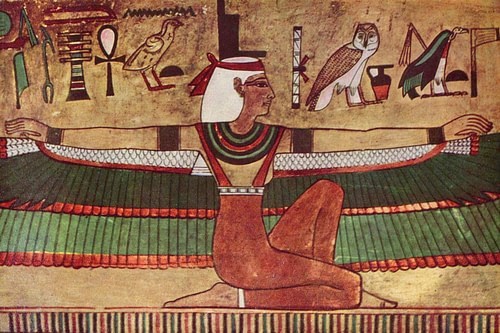
Who is Isis
Isis, or in Egyptian Auset, is the Goddess of Magic, health, marriage, nature, motherhood, fertility, purification, and womanhood. She is the eldest daughter of the Earth God Geb and Sky Goddess Nut. She is the loving wife of Osiris, sister of Nepthys and Seth, and mother of Horus.
Her magic was believed to be so powerful that she could control fate and restore health to the sick. She also has many myths surrounding her, the most notable being the Osiris myth, where she brings her husband, Osiris, back to life after he had been killed by their jealous brother Seth. Another myth she plays an important role in is the Contendings of Seth and Horus, where she assists her son Horus in taking back the throne from Seth.
Isis is a goddess with many, many aspects and domains. Along with being a beloved Goddess of the Egyptians, the Romans and Greeks loved her too, and her cult lasted well into 500 AD, when the emperor Justinian I had her priests arrested.
She is a friend to slaves, sinners, the downtrodden, the protector of people in mourning, widows, orphans, children and single mothers, and she is a patroness of Artisans, weavers, and healers. She was also thought to be the mother of the King.
Her Symbols
Throne
Tyet knot/Isis knot 𓎬
Kite bird
Scorpions
Sparrows and swallows
Cobras
Sycamore and Acacia trees
Red Jasper (symbolizing her blood)
Green scarab
The moon, lighthouses and the ocean (Roman Period)
Offerings
Tyet knot which was used to prevent miscarriage
Gardenia, jasmine, iris, blue lotus, white lily, rose, saffron
sistrums
mirrors
bloodstone, moonstone, pearls, rose quartz, lapis lazuli, aventurine, red jasper, coral, carnelian
sweet wine, pomegranate wine, water, milk
pomegranates, honey, almonds, date figs, roast duck,
frankincense and myrrh incense
perfumes
Acacia and Sycamore
Epithets
Lady of the beautiful west
Queen of Heaven
Star of the Sea
Mother of the Gods
Lover of Silence
Keeper of Secrets
Auset the sufferer/mourner (Hebrew origin)
Face of Wisdom (Hebrew Origin)
Great Lady of Magic
Lady of Joy
She who mourns
78 notes
·
View notes
Text
spoilers for TMAGP 23
It's interesting that Newman smelled Sea water and Copper during her transformation in the most recent episode. This could literally just be her smelling her blood and the coral mixing together but Copper, Salt and Water are all important parts of alchemy (Bare with me my understanding of Alchemy is still limited if I'm wrong about any of this please tell me.)
Salt: One of the Triune Nature associated with the philosophers stone and finding eternal life. It represents the body, wisdom, and perseverance. This case is labled dysphoria which would explain the focus on the body when thinking about the better you. She talks a lot about how the process is longer than expected but how she's powering through.
Its often impure when first collected then purified. This whole process is about creating a better a purer verison of herself. They're basically taking the 'purest' parts of herself and putting them in this new her. She wants the new her to be all the good bit without her mistakes
It's only one of the three elements needed to fully balance the creation of the philosophers stone which would explain why this doesn't quite work out right.
Water: One of the four classical elements respensents the essence of life, renewal and purification. It transforms and purifies being a sense of rejuvenation. The whole process is about creating a better her so it would make sense that the element associated with change and purification if present.
Also linked with intuition and the unconscious mind. Its interesting that she sees the new her in her dreams and she's scared. It kinda foreshadows how this is going to go wrong. Consciously she's super hopeful but her subconscious is scared.
It's heavily associated with the moon. Whole thing happens after the full moon, the beginning of a cycle. Further imagery associated with change.
Copper : Considered a more negative or passive symbol associated with Venus. This could be a way of showing her inexperience and how she's a bit in over her head
Respesents femine beauty, affection, and is used to promote love, sensuality, friendship, positive relationships, and peace. This is everything she wants for the new her. She talks about how she hopes people like the new her more etc
Seen as less pure than silver or gold. This could be another sign that the tranformation is less pure than it should be. Water, the moon and silver where probably her desired outcomes since silvers considered more pure? Not 100% sure on this one.
Also heavily associated with fertility. This is interesting because not only is she basically birthing a new person (even if she insists its totally different). It also seems like kids were a big reason for her break up so it's interesting that this is one of the big things she did after they ended things.
Interesting it was used to fix illnesses associated with eyes in Egypt given how much she talks about how she hopes the new her will have her eyes.
#tmagp#tmagp spoilers#the magnus protocol#magnus protocol#magnus protocol theory#tmagp 23#tmagp 23 spoilers#tmagp theory#the magnus protocol theory#the magnus protocol spoilers
32 notes
·
View notes
Text
Israel blocks entry of vital medical machines and ventilators
CNN has reported that Israeli forces have set up “arbitrary and contradictory criteria” regarding what items are allowed to enter Gaza, blocking the delivery of anesthetics and anesthesia machines, oxygen cylinders, ventilators, and water filtration systems.
“Other items that have ended up in bureaucratic limbo include dates, sleeping bags, medicines to treat cancer, water purification tablets and maternity kits,” the report added.
Since 2007, Israel’s blockade over the Gaza Strip barred Palestinians, at varying periods, from importing products such as cumin, soft drinks, shaving cream, instant coffee, and cookies. Other items include wheelchairs, footballs, lentils, and tomato paste. At the time, Palestinians circumvented these draconian bans through the use of underground tunnels, which were mainly used for commercial purposes.
UN officials and humanitarian organizations have been warning of a famine in the Gaza Strip, enabled by Israeli forces’ siege and shooting at Palestinians gathering near aid trucks, seeking to get a share of the food.
Wafa news agency reported that since Thursday, Israeli forces shot and killed Palestinians waiting for aid to arrive at the Nabulsi roundabout, dong so twice in less than 48 hours, west of Gaza City. At least 117 people were killed and hundreds were injured.
#free gaza#israel#gazaunderattack#israel is a terrorist state#genocide#gaza strip#gaza#palestine#free palestine#jerusalem#tel aviv#rafah#west bank#yemen#lebanon#news#palestine news#save palestine#savegaza#save the children#human rights violations#humanitarian crisis#humanitarian aid#human rights
57 notes
·
View notes
Text
Hyakíntha Day 1 Ritual Guide: Mourning and Preparation
1. Ceremonial Garments
The following is a recommendation, it is the choice of each worshipper what they wear throughout their day and during ritual.
Much like the modern western funeral rites of today, for the ancients it was traditional to wear dark colors. On this day of mourning wear dark colors or shades of black to mourn the passing of Lord Hyacinthus.
No jewelry or adornments are to be worn (save for those worn as part of an oath to the divine). Hair should be pulled up and heads should be covered or veiled.
2. Khernips & Purification
In the morning you should cleanse your physical body in whatever way is possible for you. Whether this is a shower - washing your face - or even just using a wipe to clean your hands - it is important to regard this day with respectful practice.
Before the ritual, it is traditional to wash ones hands with khernips (a bowl of sea water into which a flaming herb is extinguished). If sea water isn't something you have access to - mix table salt into a bowl of warm water and stir to combine.
Please note that it is perfectly acceptable to not use khernips, or to wash you hands with soap after using - or in place of - khernips.
3. Gathering at the Altar
Arrange the altar space. This should be a flat surface where you can comfortably sit or stand for the duration of the ritual.
There is no shame in sitting at a table or using a chair at your altar. Hephaestus Kyllopodiôn reminds us all that there is no shame in the need for accommodations or alterations to suit our bodies needs.
To follow along with our ritual practice, you will need:
Two candles of any kind
A cup for pouring your libation
A bowl to pour your libation into
A device through which you can play music (phone, laptop, tablet, etc.,)
Incense of any kind + an incense burner
If you do not have access to candles/incense - or cannot burn these items openly - an alternative that I have used in the past is drawing the items I do not have on a piece of paper and placing the drawing/s on my altar.
4. Opening Prayer & Deity Invocation
The ritual will start with an opening prayer to Hestia, Goddess of Hearth and Home - followed by an invocation to the God Apollo.
5. Hymns & Music
The ritual will proceed with a reading from Ovid's Metamorphese - Book Ten, subsection 'Hyacinthus' (free to read online here).
Following this reading, the song "Παῦσις" by Ancient World Music will be played in it's entirety (free to listen on YouTube here). During this time, we invite all attendees to listen to and meditate on the music. Borrowing from tradition, we also encourage attendees to lightly beat their chest to the beat of the music.
6. Libations
Certain ancient funeral rites included libations poured to the dead, consisting of milk, honey, water, wine, and other ingredients in varying quantities. For this ceremony, The Temple will be utilizing a mixture of water, honey, and white wine.
During this time, individualized prayers to Apollo and Hyacinthus are appropriate - and should be spoken before or during the pouring of the libation into the ceremonial bowl.
7. Divination
Following the pouring of libations, Hytheria Aön will be doing a tarot reading for the temple at large, seeing what messages Lord Apollo has for The Temple's patrons and visitors.
Ritual attendees/participants are encouraged to engage in their own personal divination with Lord Apollo at this time.
8. Closing Prayers
The ritual will conclude with a closing prayer to Lord Apollo, a final lament for Lord Hyacinthus, and final offerings given to Lady Hestia.
At 7:00 pm EST we will be posting a detailed script of the ritual, and at 9:00 pm EST Hytheria Aon will be performing the ritual in his home. The Temple invites all participants who are able to hold their own rituals at this same time.
If you have any questions please don't hesitate to reach out.
Eirene - peace and farewell,
- The Temple of Hyacinthus.
#Hyakintha#Hyakíntha#Hyakintha Day 1#Hyacinthus#Lord Hyacinthus#Apollo#Lord Apollo#text post#the temple of hyacinthus#helpol#hellenic polytheism
30 notes
·
View notes
Text
Stranger Danger~ {Genshin x Reader} Teyavat Chapter 14 - Teardrop Crystal
slight spoiler : There's probably going to be a slime army :D, which slime for Liyue I wonderrrr :DDD
"Welcome back!" Venti's eyes glimmered under the bar lights. "Ah, this is the Holy Lyre! You managed to retrieve it!"
"The pattern of flowing wind carved on the rosewood... and the strings still feel cool to the touch too. Oh, the memories..." You rolled your eyes. Anyone with an actual brain could tell what's wrong with his words.
Jean exchanged a glance with you. Barely shaking her head. "What do you think, Venti? Can you summon Dvalin?"
Venti shrugged, spreading his hands, "Although this lyre is the real thing, I doubt that it's going to work. As you can see, the lyre has been through a thousand years of history. Its Anemo power has run dry. In this condition, you couldn't play music fit for even Diluc's tavern with it..."
Diluc frowned, "Bards fight to get on the stage of my tavern. Don't make assumptions!"
Paimon gaped at him in disbelief, "Is that really important right now, Master Diluc!? And you - did you just borrow the Holy Lyre to play music for drunkards to hear?"
"Hehe."
Paimon's eyes widened in a cartoon like way, "What do you mean "hehe"!?"
"Anyway, we won't be able to call Dvalin with it." You sniggered at Aether's expression, if you didn't know the plot before hand, you would've slapped Venti.
Venti hurriedly changed his words upon Aether's emotionless face. "The lyre itself is fine, but the strings..."
You patted Aether's shoulder, "Time for you to do your lil magic."
"M-me?"
“He never said that it was broken."
He nodded, "It's just that the anemo power is diminished."
You leaned to Aether's ear, "Use the tear drop thingy."
His eyes widened, "I- I never told you about that." He hissed.
You fluttered your eyelashes, "Shut up and do it."
Venti grinned, "It worked, as expected.
"This youthful glow..." Jean muttered.
"Praising yourself?" Paimon gasped flabbergasted.
"It's not just a youthful glow, it fucking changed colors." You commented.
Jean raised a brow, "KEUGH KEUGH I said nothing." You waved your hands.
She sighed in exasperation, "...I was talking about the Holy Lyre."
"Thanks to Aether having purified the crystal, the Holy Lyre won't continue to lose power. That said, its power is far from replenished. It'd be great if we could get more tears."
"We'll-"
"Wait." Your eyebrows furrowed. "Jean, you didn't pay us yet."
Paimon slapped her forehead. "Oh yeah! Paimon forgot about that too!"
"Oh and we rented out a place instead of going to the inn..." you smiled largely.
Jean smiled lightly, "I'll send all of the rewards after Dvalin no longer threatens Mondstadt."
"Then the water bodies..." you wiggled your eyebrows, sparkles in your eyes.
"After Albedo finishes his experimentations."
"Ok, we'll help."
Venti's eyes remained unfocused, "Suffering alone in some deserted place..." he muttered.
"Dvalin..."
Paimon's expression turned from confusion to sadness, "Poor baby..."
"This is not something that an Honorary Knight and Y/N can accomplish alone. I will mobilize the rest of knights to assist. When you get the Teardrop Crystal, please let Aether perform the purification process."
"Leave it to me."
"Heroes supporting each other and setting out on a journey together... How exciting! Lemme come up with a song for you..."
You and Paimon side eyed him. "Is that all you're going to do? Just sing?" Paimon screeched.
"Wouldn't be much of a bard if I didn't now, would I?"
"Hmph. You're so cheeky...You deserve an ugly nickname." Paimon, nooo, stop giving people that can one shot us ugly nicknames..."Oh, Paimon knows! From now on, you'll be known as 'Tone-Deaf Bard'!"
-.-.-
(Thousand Winds Temple)
"The ruin guards aren't attacking us..." Paimon scratched her head. "OH YEAH! It's Y/N's ability!"
A strange expression emerged on Diluc's face before returning back to normal.
You coughed slightly, "I think ya'll need to kill it though, how else are you going to get that crystal?"
Jean turned to you. "Y/N, do you want to try?"
"M-me?"
"Yes, I've been wondering how it would react when you attack it." Strong curiosity could be seen through her cerulean eyes.
"But-"
"I'll pay for your rent until you leave."
"Sure!"
Your catalyst appeared besides you.
Aether gaped at you, "Where did you get that?!"
You smirked, "It's called having friends."
It didn't take too long for your smile to drop. "Oh fuck I can barely even fight. What if I fucking die?" You dragged your legs behind you.
Taking a deep breath, a ball of Anemo appeared in your hands.
The ruin guard stared down at you, as if frozen in place. As the ball of Anemo became larger and larger, you felt horrified when you noticed that it wouldn't stop.
"Y/N! That's enough to knock him out!" Aether yelled, he had no idea why you were suddenly so strong, the Anemo ball was stronger than his tornado, his eyes widened as it slowly grew to be twice your size.
Jean frowned. "Is this her first time?"
Aether paused. "I have no idea but she's definitely never summoned such a large ball."
Jean's eyes narrowed, "I'll have to knock her out if she can't control it, she'll end up in a coma if this continues, she'll also create a large enough storm to cover up the whole of Mondstadt if this Anemo ball continues increasing."
The ruin guard stared down at you. "HELP ME!" You screamed, your hair covering your face. You could feel the large amount of Anemo gathering in your body. In a blue screen that only you could see, you noticed your experience increasing in large amounts.
It was a good thing but you felt chills on your spine, you were going to faint by the enormous amount of energy roaring inside of you. It felt refreshing, but in contrast you could feel your body getting tired. You might die if this continues on.
Suddenly, you felt your body getting lighter. Lifting your head, you noticed that the ruin guard slowly walked towards the Anemo ball. As its arm touched the ball, you felt yourself regaining control of the elemental energy.
"Is it, killing itself?" Paimon shrieked.
The machine continued to walk towards you, its gears getting ripped and turned into metal dust by the reckless energy.
You panted, staggering as the entire ruin guard turned into metal dust before disappearing, a precious chest dropping in its place.
"That was unexpected." Diluc's questioning gaze landed on you before striding towards the chest.
"To sacrifice itself so that you wouldn't be depleted of elemental energy. This... is indeed very unexpected. Your pet slimes don't even seem as odd now that I think of it." Jean handed you a potion.
"This will replenish the lost energy in your body. Sucrose created the formula by accident. I'll introduce you to her soon. Sorry for almost knocking you out."
"It's fine. I didn't expect this too."
"I'll bring you to Albedo when he comes back with results with the samples across Mondstadt."
"Sorry, but umm... Paimon has been wondering since yesterday, what are you guys talking about?" Paimon giggled nervously.
"Oh? Is there a problem with Mondstadt's water? I was wondering why I saw Kaeya near the Dawn Winery."
Remembering the sample of water that Keyarye 'accidentally' dropped, a small bottle appeared in your hands. The moment you returned back home, you had split the sample of the concentrated substance in portions. You were going to give one of them to Albedo but he was probably cooped up somewhere doing experiments.
"Oh yeah! I almost forgot. You might want to give this to Albedo, he can compare it to other samples." The concentrated liquid wasn't like the diluted samples, it looked like water but to the keen eye, some differences could be spotted. From the minty tint to the light sweet smell.
"Thank you Y/N." Obviously, Jean noticed the differences, hopefully she'd give you a raise.
Clearing your throat, "Did you guys seriously not notice how all the plants around the lakes look kinda wilted and how there's less and less fish? Why'd you think a bunch of knights gathered samples of the water bodies. And come on Aether! You legit go out every single day. How brain dead are you?"
Paimon coughed, "Anywayyyy, Paimon didn't think we'd find Dvalin's tears in a place like this."
"As knights, we are taught to hone our investigative skills."
"And I ended up in prison because three knights thought I was a spy." You grumbled.
Jean sighed, holding her head. "I'll double your pay if you stop talking about that during work."
Your eyes sparkled in joy, "Ok Grandmaster!
-.-.-
(Whispering woods)
"Jean...has a turtle..." Paimon whispered dazed. "Diluc...has a turtle?...too?!"
"Paimon... Are you ok?" You poked her tummy. "Paimon... You gained weight again."
Paimon turned to you, her eyes unfocused, "Hey Y/N, did you have a pet turtle when you were young?"
"Yeah. I had...five or something but they all died because of sickness. Maybe something else."
"Y/N... had five turtles.... turtles...Ehehehe, turtles..."
Your face scrunched up. "She's..."
"Yeah, let's ignore her. Let her be in her lil world." Aether muttered. Yup, Aether sounded more and more like a Gen Z through your influence.
#genshin sagau#genshin x reader#wattpad#genshin oc#sumeru#mondstadt#aether#lumine#kamisato ayato#childe#fatui harbingers#fatui x reader#fontaine#kaeya alberich#liyue#klee#nahida#sagau x reader#sagau#scaramouche#zhongli
37 notes
·
View notes
Text

Agni Dev
Talon Abraxas
Agni Dev: Exploring the Sacred Fire God of Hindu Mythology
When we talk about the Hindu pantheon, one name that stands out is Agnidev, the god of fire. Agni, as he’s often called, plays a vital role in Hindu mythology and rituals. From sacrificial fires to the flames of a domestic hearth, Agni is everywhere. Let’s delve into the captivating world of Agnidev and understand his importance in Hindu culture.
The Many Faces of Agni
Agni isn’t just about the fire we see every day. He’s associated with various forms of fire, including:
The Sun: The ultimate source of light and heat.
Lightning: A powerful, natural force.
Comets: Celestial fireballs streaking across the sky.
Sacrificial Fire: Central to Vedic rituals.
Domestic Fires: The heart of every home.
Funeral Pyres: Guiding souls to the afterlife.
Digestive Fire: The inner energy within all living beings.
During the Vedic period (1500-500 BCE), Agni was one of the most revered deities, and the Vedas contain more hymns dedicated to him than to any other god. Even today, though not directly worshipped as much, Agni is omnipresent in various Hindu ceremonies, especially marriages and other significant rites of passage.
Agni’s Mythical Tales
Agni’s mythology is rich and varied. He is known to be the son of the Celestial Waters, symbolizing the connection between water and fire. When it rains, the fire is believed to descend to earth, only to rise again through vegetation. This cycle is a beautiful representation of the balance in nature.
One of the fascinating tales involves Agni’s reluctance to take on the duty of carrying offerings to the gods, fearing the same fate as his three brothers who perished while performing the task. To escape this duty, Agni hid in various places but was eventually discovered each time by different creatures. His final refuge, a sami tree, became sacred in Hindu rituals, with its sticks used to kindle fires. Despite his initial reluctance, Agni negotiated to receive a share of the sacrifices and was granted everlasting life.
agni dev
Agni in Hindu Art
In Hindu art, Agni is depicted in various forms:
Appearance: Agni often has black skin, two heads, four arms, and rides a goat or a chariot drawn by red horses. His two heads represent the domestic and sacrificial fires.
Symbols: He carries a fan, a sacrificial ladle, an axe, and a flaming torch or javelin.
Depictions: Sometimes shown as the Garuda bird or a goat-headed merchant, representing his role in sacrifices.
Agni’s artistic representations are not just symbolic but also a way to visualize his multifaceted nature.
Agni’s Role in Rituals and Daily Life
Agni’s presence is essential in many Hindu rituals. As a mediator between gods and humans, he carries offerings to the deities and brings their blessings to the worshippers. His role is so crucial that no significant Hindu ceremony, be it a wedding or a funeral, is complete without invoking Agni.
Agni is also considered the guardian of the southeast direction in Hindu cosmology, protecting this space as one of the eight guardians of directions (Dikpalas).
The Legacy of Agni
Over time, Agni’s prominence as a god has waned somewhat, but his legacy endures. His significance is captured beautifully in various Hindu scriptures, including the Mahabharata, the Vishnu Purana, and the Agni Purana. Agni’s tales, from his mythical origins to his role in epic battles and ceremonies, continue to inspire and fascinate.
Even today, the worship of Agni promises prosperity, protection, and a long life. Offering food and sacrifices to Agni ensures his blessings, safeguarding homes and families. The Agni Puran remains a vital source of these traditions, emphasizing Agni’s role and importance in rituals and daily life.
The Everlasting Flame of Agni
Agni, the Hindu god of fire, remains a powerful symbol of transformation, purification, and connection between the divine and the earthly. His presence in rituals underscores the importance of fire in Hindu culture, symbolizing life, death, and rebirth. As we light a fire, be it in a ritual or a simple hearth, we are reminded of Agni’s enduring presence and his vital role in the tapestry of Hindu mythology.
21 notes
·
View notes